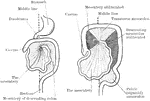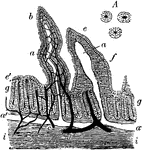Clipart tagged: ‘intestinal’

Development of the Mesenteries
Two diagrams to illustrate the development of the mesenteries. In the first figure the rotation of the…

Development of the Great Omentum
Diagram to illustrate the development of the great omentum. A, shows the beginning of the great omentum…

Rabbit's Intestinal Mucous Membrane
Vertical section of the intestinal mucous membrane of the rabbit. Two villi are represented, in one…